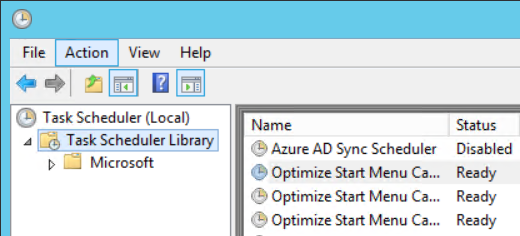When you try to remove the Azure Active Directory Sync tool , the uninstallation may not be successful, either because you did not uninstall the right product in the Programs and Features menu , or because the installation is corrupt.
In these cases, you may see the following error in the Azure Active Directory wizard: " Unable to install the Synchronization Service. PLease see the event log for additional details .
Here are some ways to manually uninstall Azure Active Directory Sync.
Uninstalling products
In the Programs and Features menu , uninstall all of the following products:
With Azure Active Directory Connect
- Microsoft Azure Active Directory Connect Tool
- Microsoft Azure AD Sync
- Forefront Identity Manager Windows Azure Active Directory Connector
- Microsoft SQL Server 2012 Express LocalDB
- Microsoft SQL Server 2012 Native Client
- Microsoft SQL Server 2012 Command Line Utilities
- Microsoft Online Services Sign-in Assistant (restart required)
- Windows Azure Active Directory Module for Windows Powershell
With Azure Active Directory Sync (standalone)
- Microsoft Azure AD Connection Tool
- Microsoft Azure AD Sync
- Forefront Identity Manager Windows Azure Active Directory Connector
- Microsoft SQL Server 2012 Express LocalDB
- Microsoft SQL Server 2012 Native Client
- Microsoft SQL Server 2012 Command Line Utilities
- Microsoft Online Services Sign-in Assistant (restart required)
- Windows Azure Active Directory Module for Windows Powershell
Deleting folders
The uninstall wizard does not remove some folders, which can cause problems during a reinstallation.
You must delete the following folders:
With Azure Active Directory Connect
- C: \ Program Files \ Microsoft Azure Active Directory Connect
- C: \ Program Files \ Microsoft Azure AD Sync
With Azure Active Directory Sync (standalone)
- C: \ Program Files Azure AD Connection Tool
- C: \ Program Files \ Microsoft Azure AD Sync
Deleting the scheduled task
You must also delete the scheduled task that starts synchronizing objects in the cloud.
- Open the Task Scheduler
- In the Task Scheduler Library container , right-click Azure AD Sync Scheduler and click Delete
Cleaning the registry
Open the registry as an administrator and delete the following keys if they still exist:
With Azure Active Directory Connect
- HKEY_LOCAL_MACHINE \ SOFTWARE \ Microsoft \ AD Sync
- HKEY_LOCAL_MACHINE \ SOFTWARE \ Microsoft \ Azure AD Connect
- HKEY_LOCAL_MACHINE \ SOFTWARE \ Microsoft \ Microsoft SQL Server Local DB
- HKEY_LOCAL_MACHINE \ SOFTWARE \ Microsoft \ MSOLCoExistence
- HKEY_LOCAL_MACHINE \ SOFTWARE \ Microsoft \ Windows \ CurrentVersion \ Uninstall \ MicrosoftAzureADConnectionTool
- HKEY_LOCAL_MACHINE \ SYSTEM \ CurrentControlSet \ Services \ ADSync
- HKEY_LOCAL_MACHINE \ SYSTEM \ CurrentControlSet \ Services \ EventLog \ Application \ AzureActiveDirectoryDirectorySyncTool
- HKEY_LOCAL_MACHINE \ SOFTWARE \ Microsoft \ Tracing \ AzureADConnect_RASAPI32
- HKEY_LOCAL_MACHINE \ SOFTWARE \ Microsoft \ Tracing \ AzureADConnect_RASMANCS
- HKEY_LOCAL_MACHINE \ SOFTWARE \ Microsoft \ Tracing \ DirectorySyncTool_RASAPI32
- HKEY_LOCAL_MACHINE \ SOFTWARE \ Microsoft \ Tracing \ DirectorySyncTool_RASMANCS
With Azure Active Directory Sync (standalone)
- HKEY_LOCAL_MACHINE \ SOFTWARE \ Microsoft \ AD Sync
- HKEY_LOCAL_MACHINE \ SOFTWARE \ Microsoft \ Microsoft SQL Server Local DB
- HKEY_LOCAL_MACHINE \ SOFTWARE \ Microsoft \ MSOLCoExistence
- HKEY_LOCAL_MACHINE \ SOFTWARE \ Microsoft \ Windows \ CurrentVersion \ Uninstall \ MicrosoftAzureADConnectionTool
- HKEY_LOCAL_MACHINE \ SYSTEM \ CurrentControlSet \ Services \ ADSync
- HKEY_LOCAL_MACHINE \ SYSTEM \ CurrentControlSet \ Services \ EventLog \ Application \ AzureActiveDirectoryDirectorySyncTool
- HKEY_LOCAL_MACHINE \ SOFTWARE \ Microsoft \ Tracing \ DirectorySyncTool_RASAPI32
- HKEY_LOCAL_MACHINE \ SOFTWARE \ Microsoft \ Tracing \ DirectorySyncTool_RASMANCS
You can now restart the installation of Azure Active Directory Connect.



You sir are the one and only that has posted the solution to my problem with reinstalling Azure AD Connect. Thanks!
ReplyDeleteEric G.
great article, although did not solve my problem. My situation was related to the fact that the new version of Azure AD Connect, now called Entra Connect (v2.3.20.0) needs TLS 1.2 to be enabled on the machine where entra ad connect is installed.
ReplyDeleteThe URL bellow explains how to check if TLS 1.2 is enabled and how to enable it.
After this and did not even need to restart the server, Entra Connect installed sucessfully.
https://learn.microsoft.com/en-us/entra/identity/hybrid/connect/reference-connect-tls-enforcement